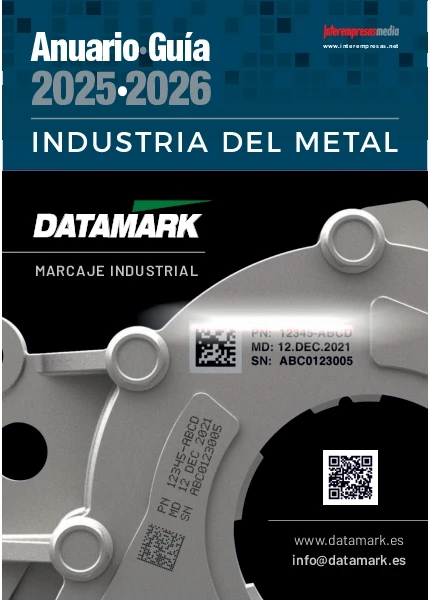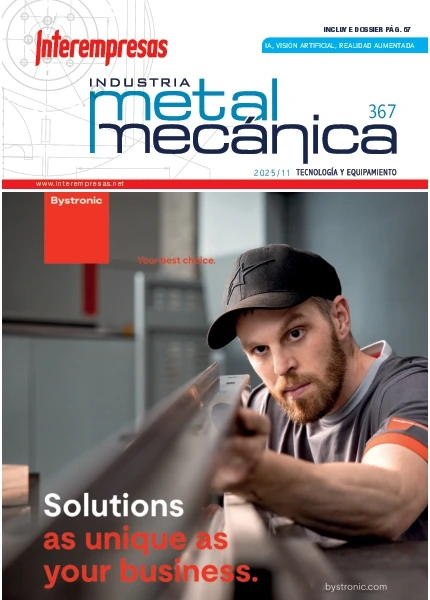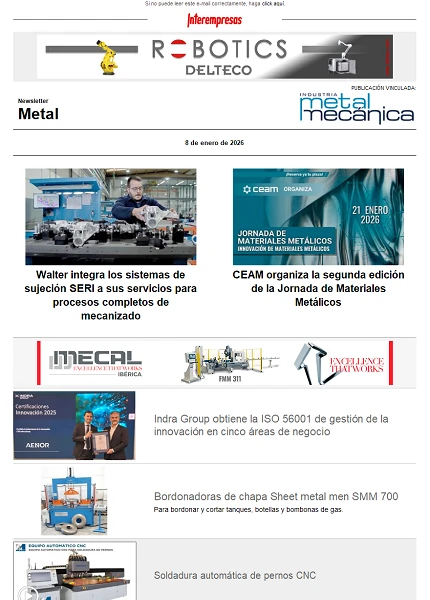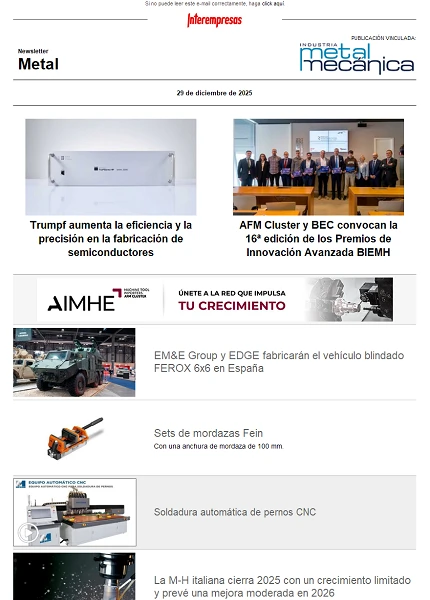La inteligencia competitiva adaptada a empresas de máquina-herramienta
Ideko Centro Tecnológico15/09/2004
La presente investigación se ha orientado en principio al sector de la máquina-herramienta, donde existen cantidades ingentes de información, conocimiento y know-how (o capital intelectual). No obstante, todo ese conocimiento acumulado necesita fluir entre las personas de la empresa de una manera fácil y natural, y debe apoyar en todo momento la toma de decisiones estratégicas.
Por consiguiente, el resultado de la presente investigación consiste en un Sistema de Inteligencia Competitiva (IC) adaptado a fabricantes de Máquina-Herramienta, basado en herramientas TIC y software personalizado que permita orientar la toma de decisiones estratégicas en cuanto a producto y tecnología, mejorando de esta manera tanto el coste de ciclo de vida como la calidad del producto final.
Necesidad y relevancia del trabajo de investigación
Desde hace varios años, las industrias involucradas en los Procesos de Desarrollo del Nuevo Producto, necesitan emprender continuamente actividades de la innovación tecnológica, siempre que quieran mantener su competitividad. Debido al cambio cada vez más rápido del entorno industrial y a la gran competencia actual (sobre todo derivada del efecto de la globalización y apertura de mercados), tanto el progreso tecnológico como una filosofía orientada al cliente son imprescindibles, para conocer y satisfacer los requisitos y exigencias cada vez mayores de los clientes, desde el principio del Ciclo de Vida del Producto. No todas las empresas pueden permitirse el lujo de llevar a cabo por sí mismos esta actividad y en caso de abordarla, la industria se ve obligada a trabajar normalmente en colaboración con los centros de investigación.
Dentro de este marco, la vigilancia de aplicaciones tecnológicas recientes, las tendencias futuras del mercado, la evolución de los procesos de mecanizando o los temas de propiedad intelectual son de vital importancia para la empresa. Actualmente, las industrias parecen tener demasiada información, sin embargo, lo realmente imprescindible no es la cantidad de información, sino una información estratégica previamente analizada y debidamente filtrada, que directamente se convierte en conocimiento, tanto en el cuadro directivo de una empresa (responsable de las decisiones estratégicas) como en todas las personas involucradas en la misma (Figura 1).
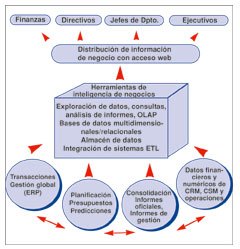
El sistema de Inteligencia Competitiva que desarrollado aporta un enorme valor añadido a las primeras fases del ciclo de vida del nuevo producto, permitiendo optimizar la definición de sus especificaciones, y supone una fase previa crucial tanto para la fase de configuración como para las sucesivas fases de la cadena del ciclo de vida del producto (diseño, fabricación, montaje, industrialización, uso y operación). Adicionalmente, la retroalimentación desde la fase de utilización por usuarios finales posibilita la recopilación de información y conocimiento, disperso pero muy importante, con objeto de optimizar aún más esa fase de configuración.
Naturalmente, es indispensable la contribución de las Tecnologías de la Información y la Comunicación (TIC) y las plataformas y entornos basados en el conocimiento. De esta manera, las empresas convencionales se transformarán en asociaciones basadas en el conocimiento dentro de una sociedad cognitiva, preparadas frente a situaciones de cambio, con todas las ventajas competitivas que todo ello conlleva.
Objetivos planteados
Por tanto, el resultado de esta labor investigadora consiste en una metodología de Inteligencia Competitiva (en lo relativo a proceso, tareas, recursos, fuentes de información…) y unas herramientas de apoyo basadas en software (procesadores de información, repositorios de información, entornos interactivos…)
Aparte del objetivo-marco general del proyecto consistente en posibilitar y facilitar la conversión de las industrias convencionales en asociaciones modernas basadas en el Conocimiento, cabe enumerar algunos otros objetivos parciales contenidos en este plan de proyecto:
- Fomentar ambientes que favorezcan el aprendizaje o el concepto de “learning organization”, compartiendo el conocimiento latente dentro de las empresas, y utilizándolo de una manera más eficiente, como soporte para la toma de decisiones estratégicas.
- El aumento del know-how y la especialización dentro de la empresa, incrementando el conocimiento colectivo (tácito) existente (recopilando la información del entorno y promoviendo el hecho de compartir conocimiento), reduciendo el período requerido para que personas recien incorporadas puedan convertirse en diseñadores expertos o gestores de producto.
- Detección, análisis y divulgación de innovaciones tecnológicas, requerimientos del mercado, tendencias futuras o los últimos movimientos de la competencia, por medio de plataformas informáticas y entornos que permiten desarrollar técnicas basadas en la Gestión del Conocimiento.
- El aumento e intercambio del capital intelectual, tanto en la fase de configuración de Nuevo Producto dentro de un marco de gestión del ciclo de vida, como en las fases siguientes, donde en todos ellos se tiene una información de entrada que se procesa, añadiéndole valor gracias a medios internos de la empresa, y convirtiéndolo en una información de salida enriquecida.
- Cuantificación de las ventajas principales de la ejecución del proyecto, para su posterior aplicación de resultados en otras empresas del entorno industrial, indiferentemente del campo de aplicación (aunque sea diferente del sector de Máquina-Herramienta). Se estima que se conseguirá un ahorro significativo en tiempo y costes, más el consiguiente aumento de eficiencia, de calidad de trabajo e integración laboral, de impacto de la imagen, de ventajas relacionadas con el género....
En definitiva, la mencionada metodología sistemática de un modelo de inteligencia competitiva orientada a empresa es el núcleo de esta investigación, para poder transformar el conocimiento en ventajas competitivas correspondientes a empresas flexibles y dinámicas, sistemáticamente preparadas para tomar decisiones estratégicas, con adaptabilidad y preparación al cambio y un remarcado know-how en cuanto a compartir conocimiento.
Mejora de competitividad y dificultades previstas
El campo de aplicación de este proyecto será la industria fabricante de Máquina Herramienta donde existe una gran cantidad información y conocimiento (o Capital Intelectual), pero no obstante, el conocimiento necesita fluir entre el personal de una manera más fácil y debe apoyar decisiones estratégicas, por medio de este Sistema de Inteligencia Competitiva. Todo esto constituirá un cambio de cultura dentro de las empresas participantes, en lo referente a la generación de conocimiento y el hecho de compartirlo. Ese Capital Intelectual existente estará en continua retroalimentación, con lo que a su vez, el tiempo requerido para que los nuevos diseñadores se transformen en expertos se reducirá significativamente.
Todo lo anterior posibilitará la transición desde la industria convencional a las asociaciones basadas en el conocimiento. Ésta será posible facilitando la evolución natural desde el Benchmarking a la Vigilancia Tecnológica y, en un paso sucesivo, hacia un Sistema de Inteligencia Competitiva.
Este sistema influirá directamente en la reducción de costes del nuevo producto y del time-to-market, y en un aumento significante de la calidad de los nuevos productos, gracias al apoyo que supondrá para la toma de decisiones estratégicas correctas referentes a Nuevo Producto y Tecnología dentro de la Fase de la Configuración en un contexto de Ciclo de Vida del Producto. Para todo ello, el sistema se va a apoyar en la identificación ó desarrollo de plataformas o entornos de software personalizados.
Finalmente, es conveniente, identificar los riesgos que se presentan para la implementación de un sistema IC. En primer lugar, entre los riesgos técnicos, hay que remarcar que las empresas deben proveerse de equipos informáticos y plataformas de software adecuados, ya que la metodología IC resultante se basará en una herramienta de software.
Pero aparte de los riesgos técnicos, se prevén más riesgos socio-culturales en el proyecto. De hecho, la realización del proyecto supone enfrentarse a un cambio de cultura importante. Frecuentemente, las empresas tienen una escasa o nula preparación al cambio, internamente puede haber miedos a compartir conocimiento, porque ello supone que ese conocimiento individual se convierte en conocimiento colectivo, con la consiguiente falta de protagonismo o prescindibilidad que supone para el individuo en cuestión.
El contexto de trabajo planteado en el proyecto deberá cambiar las rutinas e inercias existentes, y exigirá a las personas que se transformen en trabajadores cooperantes, con carácter proactivo e incluso con ciertos niveles de autogestión. De esta manera, las empresas podrán empezar a caminar hacia una sociedad basada en el conocimiento, haciendo uso para ello de plataformas electrónicas con cantidades ingentes de información (Figura 2).

Innovación tecnológica y científica
Aunque en las empresas no nacionales, estas plataformas pueden tener un mayor grado de desarrollo, aún y todo en muchas empresas europeas podemos encontrar bastante a menudo bases de datos ”frías”, en un entorno poco atractivo. Es más, el entorno cambiante donde se mueven las empresas son la mayor causa de una alta “caducidad” de las bases de datos, y ello conlleva el riesgo de que no estén actualizadas y se vuelvan obsoletos en un breve período de tiempo.
Por consiguiente, como hay muchas soluciones genéricas basadas en software pero ninguna plataforma ni metodología sistemática orientada al sector de la Máquina-Herramienta, hay una necesidad creciente de personalizar las soluciones actuales o de desarrollar nuevas plataformas de uso fácil. Además, se requiere un repositorio de información personalizado, con alimentación continua de información estratégica para apoyar la toma de decisiones estratégicas de una empresa.
En este contexto, el apoyo de las Tecnologías de Información y de Comunicación (TIC) es imprescindible, ya que una metodología IC basada en una plataforma atractiva (portales interactivos o herramientas multimedia, por ejemplo) favorece un entorno donde se comparte información y conocimiento de alta especialización, y posibilita una comunicación interna más eficaz dentro de la empresa.
En los últimos años, en los programas de I+D de la Comunidad Europea, ha habido muchos proyectos en la línea de Gestión del Conocimiento y de Gestión del Ciclo de Vida del Producto, lo cual nos da idea del estado del arte en estos momentos. Sin embargo, la novedad de la investigación abordada reside en que se define un sistema de Inteligencia Competitiva que contempla al mismo tiempo ambos entornos, y esta combinación ha sido muy poco frecuente hasta ahora en los proyectos europeos de investigación.
En este contexto, cabe señalar que es cada vez mayor el número de empresas norteamericanas que está orientando y dirigiendo sus Políticas de Innovación mediante actividades de Inteligencia Competitiva, mientras que en Europa hasta ahora no ha sido tan habitual oír hablar de este término (Figura 3). Estas actividades de Inteligencia Competitiva se pueden llevar a cabo por departamentos internos dentro de la compañía o bien mediante firmas consultoras externas.
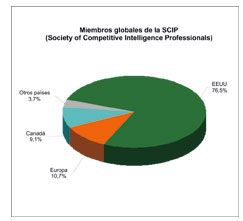
(fuente: SCIP, Society of Competitive Intelligence Proffesionals)
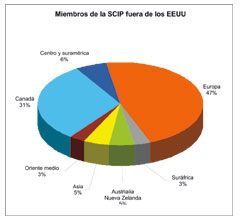
Método de Investigación
En primer lugar, es necesario aclarar las principales diferencias entre dato, información y conocimiento. El ‘dato frío’ necesita una interpretación para convertirse en ‘información’. Adicionalmente, esta ‘información’ analizada y filtrada requiere de un contexto y un contraste con el know-how interno, para transformarlo en ‘conocimiento’. Y el objetivo no consiste sólo en recopilar y almacenar ese conocimiento, sino en comunicarlo, en hacerlo fluir, hasta hacerlo llegar a las personas involucradas para que sea de utilidad en cualquier decisión estratégica futura. (Figura 4).
Para conseguir los objetivos planteados en la presente investigación, se ha seguido una metodología inicial (Figura 5) con algunos pasos a seguir:
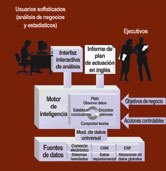


En primer lugar, es necesario identificar los principales ‘actores’ de un marco de Inteligencia Competitiva (Figura 6), es decir las fuentes de información más adecuadas (técnicas, de producto, de proceso…), noticias de mercado, información y tendencias sectoriales, evolución económica. En este punto de partida, es un factor clave la correcta identificación de las bases de datos más completas, ediciones técnicas, congresos y conferencias, ferias especializadas, competidores, proveedores, clientes.
Al mismo tiempo, esta metodología requiere la identificación de las herramientas TIC más adecuadas que puedan servir de soporte a la Inteligencia Competitiva (metabuscadores, procesadores de datos, agentes inteligentes, repositorios de información, software específicos y personalizados…)

Una vez identificados los datos y la información de interés, se debe capturar esa información mediante las herramientas TIC, de una manera sistemática y automatizada, puesto que no es una tarea donde se añada valor y puede ser optimizada con las tecnologías de la actualidad.
Seguidamente viene una de las fases cruciales de la metodología, el análisis y filtrado de la información obtenida, ponerla en contexto (para así transformarla en conocimiento) y contrastarla con el conocimiento y el know-how ya existentes en el seno de la empresa. En esta etapa es aún pronto para intentar reemplazar a la inteligencia humana, y de momento, no se preve fácil automatizarla mediante las herramientas TIC, si bien es cierto que se están realizando avances muy importantes en cuanto a herramientas semi-inteligentes (minerías de datos, minerías de textos, summarizers…)
El hecho de filtrar la información y extraer el núcleo estratégico es imprescindible en esta fase, más aún en estas fechas en las que se tiene un exceso información, lo cual puede llegar a ser tan perjudicial como su defecto.
Reposición de Conocimiento y comunicación (compartir el conocimiento):
Una vez que la información ha sido capturada, filtrada y analizada (con lo cual los datos se han transformado en información, y seguidamente en conocimiento), es imprescindible concienciarse de que falta aún la última fase, la más importante, consistente en comunicar esta información y conocimiento estratégicos a las personas de la empresa involucradas en la toma de decisiones acerca de los planes de futuro, inversiones, desarrollo de nuevos productos…
Es un grave error pensar que el objetivo final consiste en recopilar toda la información posible. Lo que se pretende es transmitir este conocimiento y hacerlo fluir en la empresa, a quien se considere necesario y oportuno, para que le sirva de apoyo cara a las decisiones estratégicas. Por ello, es necesario recopilar esta información analizada y filtrada en una plataforma software, debidamente categorizada y clasificada para agilizar futuras consultas y búsquedas, consiguiendo así que esté accesible al personal adecuado, en una manera atractiva y sencilla de usar.
Finalmente, quedaría resaltar la conveniencia de habilitar sistemas de retroalimentación hacia la fase inicial, lo cual optimizaría la metodología, corrigiendo posibles desviaciones y añadiendo nuevas fuentes de información. En definitiva, se trata de una vez definido el sistema de Inteligencia Competitiva, mantenerlo actualizado tanto en la propia metodología como en cuanto a contenidos.
Grado de innovación, resultados y trabajo futuro
En definitiva, se ha definido un sistema de Inteligencia Competitiva orientado a empresas de tamaño mediano-pequeño que sean fabricantes de productos no seriados (p.ej. Máquina-Herramienta). De hecho, actualmente existen sistemas similares para el caso de grandes multinacionales con un producto totalmente seriado, pero no se han adaptado de una manera metodológica al caso que nos concierne.
Es conveniente recordar una vez más la ventaja fundamental de este sistema de Inteligencia Competitiva. Las decisiones más estratégicas de la empresa se tomarán de acuerdo a la información más reciente y los últimos movimientos en lo relativo a mercado, tecnología y competencia (algo absolutamente necesario en el actual ‘mundo acelerado’), y al mismo tiempo, ello supondrá el poder compartir conocimiento entre las personas involucradas en la definición y desarrollo de nuevos productos. Todo ello redundará en una mejora de la calidad del producto final y una significativa reducción en el parámetro de time-to-market.
Naturalmente, cuando el sistema de Inteligencia Competitiva esté consolidado, supondrá un cambio cultural para las empresas, puesto que tomarán sus decisiones estratégicas de una manera sistemática y de acuerdo con la evolución del mundo industrial actual (en vez de tomarlas exclusivamente guiados por la intuición), y ello posibilitará la transición desde la industria convencional a empresas dinámicas y flexibles, basadas en el conocimiento.
Cara a futuro, resta refinar la metodología inicial definida y definir e implementar algunas aplicaciones piloto en nuestro entorno industrial. Las conclusiones que se puedan extraer de estas experiencias podrán ser retroalimentadas y optimizar tanto la metodología definitiva, como la adaptabilidad de las herramientas TIC que nos faciliten la labor. Al mismo tiempo, se considera necesario medir o cuantificar el progreso que se esté experimentando, definiendo para ello unos indicadores de éxito adecuados.
Finalmente, resta mencionar el marco en el que se encuadra este sistema de Inteligencia Competitiva, esto es, las primeras fases del proceso de desarrollo de nuevos productos, cuando es necesario definir sus especificaciones en base a la evolución actual de mercado y tecnología. Este marco de trabajo va a tener una evolución natural hacia un sistema de gestión total de producto que contempla todas y cada una de las fases comprendidas en el Ciclo de Vida del producto, incidiendo en las posibles interrelaciones entre fases (relaciones causa-efecto y sistemas de retroalimentación). Términos como el coste de ciclo de vida, gestión del conocimiento, configuración y desarrollo de nuevos productos, inteligencia competitiva ó entornos de aprendizaje serán conceptos habituales de este enfoque holístico que se le va a dar al proceso de creación de nuevos productos.
Referencias
- Allen, T. J. (1985), Managing the flow technology. Cambridge, MA: MIT Press.
- Ashton, W.; Stacey, G.S. (1995), Technical intelligence in business: understanding technology threats and opportunities, International Journal of Technology Management, Vol.10, Núm.1, pp.79-104.
- Coburn, M. M. (1999), Competitive Technical Intelligence. Oxford: Oxford University Press.
- Dou, H. (1997), Technology watch and competitive intelligence: the european way, Competitive Intelligence Review, Vol.8, Núm. 1, pp. 78-83.
- Dumas, S. (1994), Développment d´un Système de Veille Stratégique dans un Centre Technique. Tesis Doctoral. Universite de Droit et des Sciences d´Aix-Marseille. Francia.
- Escorsa, P.; Rodríguez, M. (1997), De la Información a la Inteligencia tecnológica: Un avance estratégico, VII Seminario Latinoamericano de Gestión Tecnológica, Altec.
- Escorsa, P.; Rodríguez, M.; Maspons, R. (2000), Technology mapping, Business strategy, and market opportunities, Competive Intelligence Review, Vol. 11,Núm. 1.

